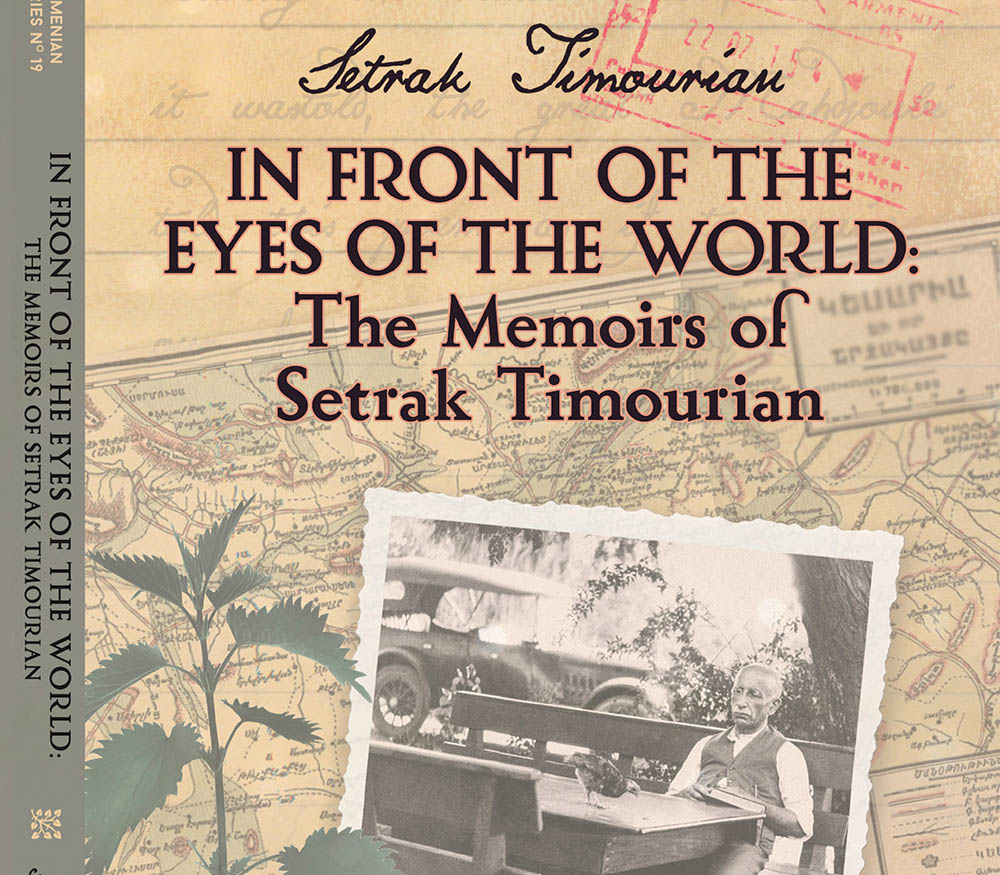 Conor Youhei Hustedde and
Conor Youhei Hustedde and
Barlow Der Mugrdechian
The Armenian Studies Program at Fresno State continues to be a prominent publisher of all things Armenian with installments 18, 19 and 20 of the Armenian Series. The series began with their first book, “Young Saroyan: Follow and Other Writings,” released in 2009 and continues its rigorous publishing efforts with each volume examining new aspects of Armenian life, culture and history.
“The Armenian Series is important because it publishes works that have a general interest in the field of Armenian Studies. It is the most active university Armenian series in the United States,” said Professor Barlow Der Mugrdechian.
Published through The Press at California State University, Fresno, the series continues with three new must-reads: “Western Armenian Music: From Asia Minor to the United States,” “In Front of the Eyes of the World: The Memoirs of Setrak Timourian” and “Death Marches Past the Front Door.”
“These three books are exciting because they add a great deal to the Press. They cover Armenian music, memoirs, and the story of Swiss eyewitnesses to the Genocide. Each is interesting and will be of wide interest,” Der Mugrdechian said.
 “Western Armenian Music: From Asia Minor to the United States” by Hachig Kazarian
“Western Armenian Music: From Asia Minor to the United States” by Hachig Kazarian
Armenian Series #18 –
Available now from Abril Books
Silenced for over one hundred years, the Western Armenian music brought to America by the first Armenian immigrants has become an integral part of Armenian culture in the United States. “Western Armenian Music: From Asia Minor to the United States” examines the many facets of Western Armenian music and how it has been neglected due to the Armenian Genocide of 1915 and the deleterious effects upon the Armenian people. The author discusses such topics as the Modal System used in Armenian folk and sacred music since the 8th century; traits and characteristic elements of Armenian music; the 19th-century Armenian musical notation created by Hampartsoum Limonjian; and the two opposing styles of Western Armenian music performed in the United States. Western Armenian Music also describes how the children of the first-generation Armenian immigrants started Armenian bands as an effort to keep Armenian culture alive in the United States. As a way to preserve the music of the first immigrants to the United States, this volume also includes over 100 Armenian dance songs with notations.
Hachig Kazarian was born in Detroit, Michigan, to immigrant parents of the Armenian Genocide. He is a retired secondary instrumental music educator with 46 years of teaching experience, which includes a suburban Detroit school system and the Clark County schools in Las Vegas, Nevada. He received his professional credentials from the Juilliard School of Music, where he earned a B.S. and M.A. degree in clarinet performance. He also attended Eastern Michigan University, where he received an M.A. degree in Music Literature/Ethnomusicology.
Kazarian has performed Western Armenian music for many Armenian churches, societies and patriotic organizations throughout the United States. He has been a leading role model for many young Armenian-American clarinetists for decades and performs as an Armenian immigrant musician taught him.
The motivating factor for producing this book was the lack of concrete information and the misunderstanding of this beautiful form of Armenian music, “Western Armenian Music from Asia Minor.”
“In Front of the Eyes of the World: The Memoirs of Setrak Timourian” 
Translated by N. Ipek Hüner and edited by Vahé Tachjian, Yaşar Tolga Cora, Murat Cankara and Barlow Der Mugrdechian.
Armenian Series #19 –
Available now from Abril Books
“In Front of the Eyes of the World: The Memoirs of Setrak Timourian” gives the reader a fascinating and detailed story of the life of Setrak Timourian. Born in 1860 in Kayseri, Timourian documented his life, the life of his family and his many adventures. He lived during an eventful period in Armenian and Ottoman Turkish history and thus provided insight into the life of Armenians. His travels to Constantinople and then later to the United States chronicle his life as a carpet merchant and the many challenges that he faced. He also recorded his views on the important events of the day. The memoir is an invaluable record of one man’s indomitable spirit and enthralling life story.
 “Death Marches Past the Front Door – Clara and Fritz Sigrist-Hilty: Swiss Eyewitnesses to the Armenian Dante-Inferno in Turkey (1915-1918)” by Dora Sakayan
“Death Marches Past the Front Door – Clara and Fritz Sigrist-Hilty: Swiss Eyewitnesses to the Armenian Dante-Inferno in Turkey (1915-1918)” by Dora Sakayan
Armenian Series #20 –
Available now from Abril Books
April, 1915. On the day of their church wedding, the civil engineer Fritz Sigrist and the nurse Clara Hilty take the train from Werdenberg, Switzerland and travel through the war zone across the Balkans to southeastern Turkey. After Turkey’s involvement in World War I as Germany’s ally, it was certainly not the ideal place for a honeymoon, but Fritz had been working on the construction of the Baghdad railway since 1910. After a short stop in Constantinople, the newlywed couple settled down for a few months in Entilli, then for three years in Keller.
Shortly after they arrived in Turkey, the Armenian deportations began and thousands of Armenians were marched past their front door. For three years, the couple witnessed “the lapsing of human lights down there in the steep gorge” while they lived their everyday life in their little house on the remote hillside. A visit to Aleppo and the Katma concentration camps makes them realize that what they were seeing in Keller on a daily basis was nothing less than premeditated death marches, that is, the Armenian Genocide. Things become worse when the skilled Armenian workers – actively involved in the Baghdad railway construction – are also forced to join those death marches. Clara records the atrocities, first in her journal and later in a memoir or a special eyewitness account. Fritz, in his turn, writes two stories and a letter on the subject.
Dora Sakayan has deciphered the Swiss archive documents written primarily in Gothic handwriting and has meticulously processed them and embedded them in the historical events of the time. Moreover, based on a 1970 memoir by Haig Aramian, Sakayan recounts the adventurous story of how, in June 1916, the Sigrist-Hilty couple helped their Armenian storehouse manager, Aramian, escape certain death.
Sakayan’s book consists of three parts, each dedicated to the life and writings Clara Hilty, Fritz Sigrist and Haig Aramian. An organic interplay of primary and secondary texts relates to the reader a coherent real-life story – one of extreme human suffering and pain but also of Christian charity, compassion and selflessness.
Born in 1931 in Salonica (Greece) to Armenian refugees from Asia Minor, Sakayan had a long and eventful life. She received her primary education at the local Armenian Gulabi Gulbenkian school and the German school “Deutsche Schule Thessaloniki” and her secondary education at a girls’ “Gymnasium” in Vienna (Austria).
In 1946, the Sakayan family of four was repatriated to what was then the Armenian Soviet Republic. In 1952, Sakayan graduated from the Yerevan Pedagogical Institute of Foreign Languages with the specialization “Instructor of German.” In 1965, she attained a Doctorate in German philology at the Moscow Lomonosov State University. She then taught German at Yerevan State University (YSU), where she also headed the Department of Foreign Languages.
In 1975, Sakayan moved to Canada and continued her pedagogical career as a Professor of German Studies at McGill University in Montreal, where she gradually ventured from German Studies to Armenology. She has written, edited, and translated more than 30 books.
 Hye Sharzhoom Armenian Action
Hye Sharzhoom Armenian Action